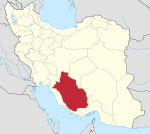Tomb of Saadi
 |
| Part of a series on |
| Saadi Shirazi |
|---|
| Books |
|
| Related Topics |
| Monuments |
|
|
The Tomb of Saadi, commonly known as Saadieh (Persian: سعدیه), is a tomb and mausoleum dedicated to the Persian poet Saadi in the Iranian city of Shiraz. Saadi was buried at the end of his life at a Khanqah at the current location. In the 13th century, a tomb was built for Saadi by Shams al-Din Juvayni, the vizir of Abaqa Khan. In the 17th century, this tomb was destroyed. During the reign of Karim Khan Zand, a mausoleum of two floors of brick and plaster, flanked by two rooms, was built.[1] The current building was constructed between 1950 and 1952[2] to a design by the architect Mohsen Foroughi and is inspired by the Chehel Sotoun with a fusion of old and new architectural elements. Around the tomb on the walls are seven verses of Saadi’s poems.
The new building
The new building was constructed in Persian style. It includes 8 brown stone pillars at the front of the tomb. The main structure is made of white stones and tiles. The building of the tomb of Saadi Shirazi has a cubic shape from the outside, but from the inside, it is in the form of an octagon with walls of marble and an azure arch. The tomb of Saadi Shirazi has an area of about 257 square meters. The main building of the tomb includes two terraces that are perpendicular to each other. The tomb of Saadi is located at the angle of these terraces. Over the tomb, there is an arch made of turquoise tiles. The stones of the bases of the structure are black, and the pillars and the front part of the terrace are made of red granite stone. The facade of the tomb is made of travertine stone, and the interior is made of marble.[3]
The fish pond
This pond lies on the left side of the tomb of Saadi Shirazi. It has an octagonal shape and an area of about 30.25 square meters.
The coin pond
At the front of the terrace, there is a pond where visitors often throw coins.
The aqueduct
10 meters below the tomb of Saadi Shirazi, there is an aqueduct whose water contains sulphurous material and also quicksilver.[4]
Gallery
-

-

-

-
 April 2008.
April 2008. -
-
 c. 1840.
c. 1840. -
 c. 1840, by Eugène Flandin
c. 1840, by Eugène Flandin
See also
Notes
- ^ Stanley, Henry Morton (2011). My Early Travels and Adventures in America and Asia. Cambridge University Press. p. 402. ISBN 9781108032988. Retrieved 2016-05-08.
- ^ Baker, Patricia L. (2014). Iran. Bradt Travel Guides. p. 182. ISBN 9781841624020. Retrieved 2016-05-08.
- ^ The new Building (2021-07-14). "Tomb of Saadi Shirazi". TourInPersia.
- ^ Javadian, Azam (2017-11-04). "Saadi's Tomb". Iran Watching.




















